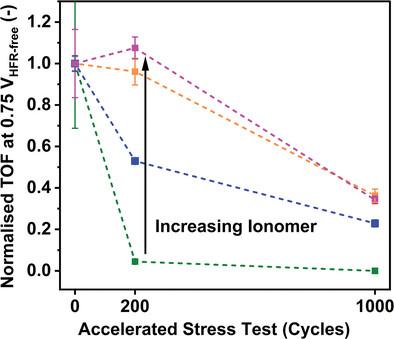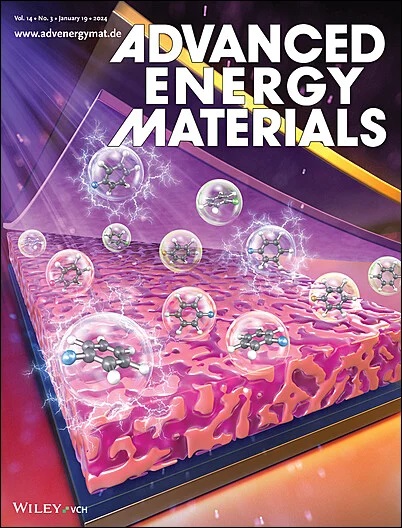质子交换膜燃料电池中的 Fe-N-C:离子聚合物负载对降解和稳定性的影响
IF 24.4
1区 材料科学
Q1 CHEMISTRY, PHYSICAL
引用次数: 0
摘要
在质子交换膜燃料电池(PEMFC)阴极的氧气还原反应中,N-掺杂C(Fe-N-C)中的铁单原子是最有希望取代碳支撑铂基催化剂的催化剂。然而,I/C 比如何影响 Fe-N-C 降解和单个铁原子活性位点(FeNx)的稳定性仍不清楚。在此,我们将加速应力测试 (AST) 协议与新兴电化学技术相结合,对 PEMFC 中的多孔 Fe-N-C 进行了一系列 I/C 比测试。结果发现,PEMFC 的电流密度降解率相当;但是,随着 I/C 比的增加,接入的额外 FeNx 位点更加稳定,这表现在 AST 方案结束时,其活性位点稳定数(每损失一个 FeNx 位点通过的电子数)更高。同时,随着 I/C 的增加,TOF 的初始衰减率也会受到抑制。通过弛豫时间分布分析研究了电化学过程的变化。低电流密度下 H+ 和 O2 传输阻力的微小变化证明了高电位下的动力学降解占主导地位。这些发现证明了如何将电化学技术与稳定性指标相结合,以确定和解构 PEMFC 中从活性位点到器件级电化学过程的变化。本文章由计算机程序翻译,如有差异,请以英文原文为准。

Fe-N-C in Proton Exchange Membrane Fuel Cells: Impact of Ionomer Loading on Degradation and Stability
Fe single atoms in N-doped C (Fe-N-C) present the most promising replacement for carbon-supported Pt-based catalysts for the O2 reduction reaction at the cathode of proton exchange membrane fuel cells (PEMFCs). However, it remains unclear how the I/C ratio affects Fe-N-C degradation and the stability of single Fe atom active sites (FeNx). Here, an accelerated stress test (AST) protocol is combined with emerging electrochemical techniques for a porous Fe-N-C in PEMFC with a range of I/C ratios. The PEMFC current density degradation rates are found to be comparable; however, with increased I/C ratio the additional FeNx sites accessed are more stable, as shown by their higher active site stability number (electrons passed per FeNx lost) at the end of the AST protocol. Meanwhile, the initial rate of TOF decay is suppressed with increasing I/C. Electrochemical process changes are studied via distribution of relaxation times analysis. Minor changes in H+ and O2 transport resistance at low current density prove kinetic degradation dominants at high potentials. These findings demonstrate how electrochemical techniques can be combined with stability metrics to determine and deconvolute changes from the active site to device level electrochemical processes in PEMFCs.
求助全文
通过发布文献求助,成功后即可免费获取论文全文。
去求助
来源期刊

Advanced Energy Materials
CHEMISTRY, PHYSICAL-ENERGY & FUELS
CiteScore
41.90
自引率
4.00%
发文量
889
审稿时长
1.4 months
期刊介绍:
Established in 2011, Advanced Energy Materials is an international, interdisciplinary, English-language journal that focuses on materials used in energy harvesting, conversion, and storage. It is regarded as a top-quality journal alongside Advanced Materials, Advanced Functional Materials, and Small.
With a 2022 Impact Factor of 27.8, Advanced Energy Materials is considered a prime source for the best energy-related research. The journal covers a wide range of topics in energy-related research, including organic and inorganic photovoltaics, batteries and supercapacitors, fuel cells, hydrogen generation and storage, thermoelectrics, water splitting and photocatalysis, solar fuels and thermosolar power, magnetocalorics, and piezoelectronics.
The readership of Advanced Energy Materials includes materials scientists, chemists, physicists, and engineers in both academia and industry. The journal is indexed in various databases and collections, such as Advanced Technologies & Aerospace Database, FIZ Karlsruhe, INSPEC (IET), Science Citation Index Expanded, Technology Collection, and Web of Science, among others.
 求助内容:
求助内容: 应助结果提醒方式:
应助结果提醒方式:


